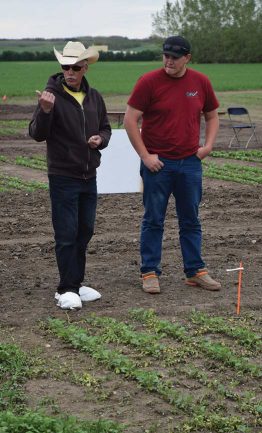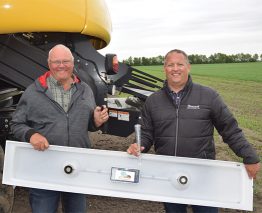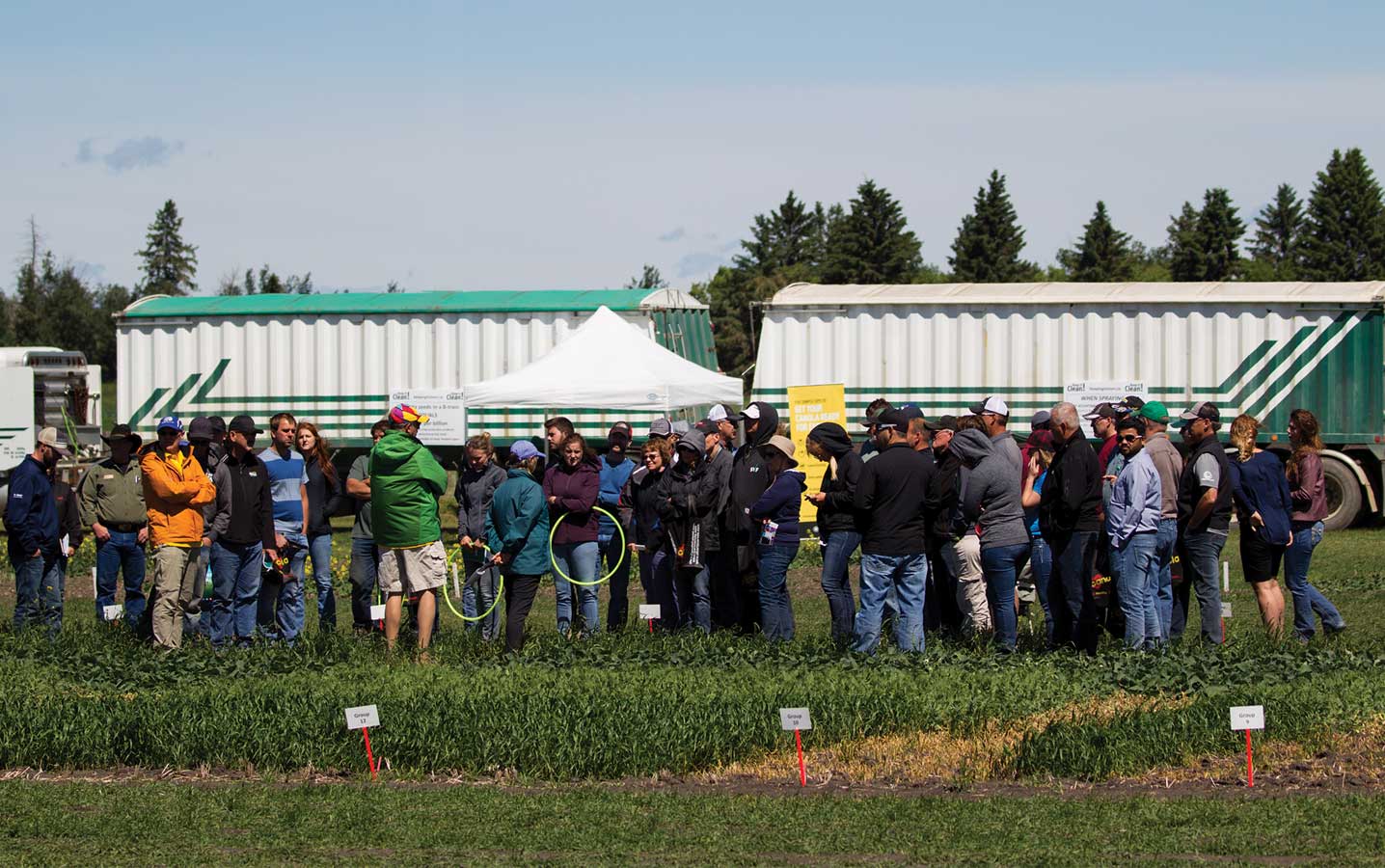What attendees learned at canolaPALOOZA 2017
Advice from the pit boss
When I go to an event, I try to find three things I can take home,” says Brian Tischler, who farms at Mannville, Alberta. His number one “by far” from canolaPALOOZA 2017 at Lacombe, Alberta, came from Ross McKenzie and his soil pit. McKenzie is a retired agronomy research scientist who worked 38 years with Alberta Agriculture.
Luke Jantzen on phosphorus:
After talking with Ken Panchuk, provincial soil specialist with Saskatchewan Agriculture, Luke Jantzen and his father Fred, who farm at Rosthern, Saskatchewan, will strive to keep phosphorus levels in their soils at 15 ppm or higher. This is the threshold for deficiency, Panchuk says, and 80 per cent of Saskatchewan soils have dropped below this critical level.
To demonstrate the value of low disturbance farming for good soil quality, structure and water-holding capacity and for erosion prevention, McKenzie had two cylinders of clear water. In one he put a clump of topsoil from a no-till field and in the other a clump from a heavily-tilled field. The no-till soil stayed as a clump, soaking up water like a sponge. The clump from the tilled field “melted and disintegrated like a sugar cube”, Tischler says.
Besides the clear improvement in soil structure for no-till soil, this demo also showed Tischler how tilled soil crusts after a rain. Increased organic matter in no-till soil acts like a glue to bind particles into a good structure to resist erosion and soil crusting. “With rain, worked soil melts and then turns into rock again when it dries,” he says. This helped to reinforce for Tischler the low-disturbance, high-residue management practices he uses on his own farm.
From the pit, McKenzie explained the value in knowing how soils on a farm were deposited, formed and developed. “This can help a farmer understand how and why soils are variable and what types of soil and crop management are best,” McKenzie says. For example, soils in areas that were once old glacial lake beds are often higher in clay, have few stones, have much less soil variability and much more uniform topography. Glacial-deposited soils often have more variable soil texture with more rolling topography.
“Knowing the parent material of your soils is very useful to determine if and when variable rate fertilizer management is economically beneficial,” McKenzie says. “That’s why, when working with a company to develop soil and crop management zones, make sure the agronomist you are working with is well trained in soil fertility and has taken soil mapping and classification to ensure you are getting the best advice.”
Tischler’s other two highlights from canolaPALOOZA were the pest updates, especially descriptions of the new midge, and Tom Wolf’s continuous rinse idea for sprayers. (For more on Wolf’s station, read the spray cleanout section on page 29.) For more about Brian Tischler and how he farms, search for his “farmerbriantee” videos on YouTube and follow @efarmerdot on Twitter.
For more agronomy tips from canolaPALOOZA, read “Top 10 canolaPALOOZA 2017 highlights” at canolawatch.org.
Help the herbicides

Kregan Warrington farms and works in an area of Western Saskatchewan fairly new to canola. In fact, the Warrington farm at Hoosier grew canola for the first time this year.
Warrington is in the crop technology program at Lakeland College in Vermilion, Alberta and is a summer agronomy specialist with G-Macs in Marengo, Saskatchewan. He attended canolaPALOOZA for one-stop access to various experts and a crash course in canola agronomy.
At the weeds station, Saskatchewan Agriculture weed control specialist Clark Brenzil gave him a personal tour of the plots, showing how spray timing improves the return on a herbicide investment (the “critical period of weed control” in canola is at or before the 4-leaf stage of the crop) and how canola plant population can improve crop competition.
A key point Brenzil wanted to get across in his station is that heavy reliance on herbicides as the primary weed management tool will mean continued increases in herbicide-resistant weeds by herbicide group, weed species and overall abundance. Higher plant populations, timely early herbicide applications and narrower row spacing are three steps to improve crop competition, cut down on the need for a second in-crop herbicide spray and help to reverse the trend of herbicide-resistant weeds.
“It was a good opportunity to learn these natural ways to deal with weeds instead of just applying more herbicide,” Warrington says.
Are you ‘SCHER’ about harvest losses?

Louise Carduner, customer service rep with Parrish & Heimbecker at Quill Lake, Saskatchewan, was most impressed with Pat and Trevor Scherman. The father and son, who farm together at Battleford, Saskatchewan, demonstrated their drop-pan system to measure harvest losses.
“I love meeting farmers who are so passionate about what they do,” Carduner says.
The Schermans’ ScherGain heavy plastic drop pan connects to the underside of almost any combine make or model by magnets. With the chopper and chaff spreaders disengaged and the combine moving at the desired speed and settings, the combine operator uses a small remote key fob to release the magnets and drop the pan.
After removing the chaff and straw by hand and with screens, collected seed goes into a “grain gauge” for ScherGain’s simple evaluation method. The reading on the gauge cross-referenced to the cut width (swather or straight-cut header) will tell you the losses in bu./ac.
For example, in canola if the gauge reads 70 and the header width is 35 feet, the loss is 2 bu./ac.
Their pamphlet says: “The most money per hour you will ever make farming is setting your combine and knowing your losses.” Whether it’s the “most” money is subject for debate, but the CCC expects overall average canola yields across the Prairies could increase by at least 2 bu./ac. with improved harvest management. Reducing losses is a big part of the message.
For more on the pan and the system, including how-to videos, go to schergain.ca.
“Harvesting at 2.8 mph seems too slow for a 500-horsepower combine, but you never know the right speed and settings until you measure losses,” Trevor says.
—Carduner recorded and tweeted a short video about the pan while she was at canolaPALOOZA. It generated an immediate bump in sales for ScherGain and, as Carduner says, “demonstrated again the power of social media.” Follow her on Twitter at @LouiseCarduner.
Tips for fast, effective sprayer clean-out
A highlight for Luke and Fred Jantzen, son and father who farm together at Rosthern, Saskatchewan, was how to do a better job of washing out the sprayer. “The most important point is to do it right away after spraying,” Luke says. “And a number of smaller washes is better than one big one with lots of water.”
This small-batch triple rinse is one sprayer-cleanout improvement Tom Wolf presented at canolaPALOOZA. Wolf is a long-time sprayer researcher and runs AgriMetrix and sprayers101.com.
Wolf’s goal is to make sprayer cleanout more effective, faster, convenient and environmentally friendly.
Wolf’s second method is continuous rinsing. With both triple rinse and continuous rinse, the first step is to start with the right amount of spray volume for the field size so the operator can spray the tank empty in the field. Both steps also require an auxiliary tank of clean water — ideally 150 to 200 gallons.
Triple rinse.
“Three small rinses of 50 gallons each are about ten times more effective than one rinse of 150 gallons,” Wolf says. The key is to have as small a remainder volume in the tank as possible. After spraying out the product tank to empty, use the sprayer solution pump to draw 50 gallons into the tank via the wash down nozzle. Agitate and spray it out. Repeat this two more times, all in the field.

Continuous rinse.
After the product is sprayed out, leave the main solution pump on and keep driving. Engage a second clean-water pump that draws water from the clean-water tank and runs it through the tank wash-down nozzle. While the two pumps run simultaneously, one pumping clean water into the rinse system and the other sucking rinsate through the booms and nozzle, the operator goes back over the field until the process is done. “This will probably take just a few minutes,” Wolf says. Rinse water will start off with some pesticide in the mix and rapidly dilute down until clean water comes out the nozzles.
One challenge with continuous rinse, Wolf says, is that in-flow has to match out-flow to maximize the benefit – and clean-water pumps that match the flow rate of the main pump can be hard to find. (But they are out there.) Another challenge is that some sprayer manufacturers don’t allow additional pumps tapped into the hydraulic system, meaning that air- or electric-drive pumps need to be used.
My canolaPALOOZA highlights
I don’t think many growers are aware of how little herbicide residue it can take to damage their crops. Looking at the canolaPALOOZA plots, I was surprised to see there was still leaf cupping in canola at 1/128th rate of herbicide!
There’s always so much going on in a crop, it can be difficult to pinpoint where an issue stems from. Because of this, making sure I take proper measures (i.e. triple rinsing the sprayer tank) to keep potentially damaging herbicide residue off my crops and the crops of my growers is vital.

popular conversation centres at all three canolaPALOOZAs.
I took away so much from canolaPALOOZA, it’s hard to narrow down what the “best” thing would be. I was fascinated by the beneficial insect station. I loved the setup where you could stick magnetic insects to parts of a canola plant to learn where each species does the most damage. The insect traps they set up were interesting as well. I also always enjoy the fertilizer plots to see what combinations and rates of different elements can be put down to benefit a crop, and seeing at what rate they start to become detrimental to canola growth.
One of the biggest takeaways that I had from canolaPALOOZA was seeing just how many different factors contribute to the success of a canola crop – for example, fertilizer rates, harmful versus beneficial insect populations, seed varieties, spray residue and timing and soil conditions – among other things. We’ve learned so much about all these different aspects of a crop and can use them to our advantage to see increasingly higher yields, yet we still have so much to still explore and work with.
—Bailey Ogilvie is a University of Saskatchewan student and sales and agronomy assistant with Dekalb in Southwest Saskatchewan. Her family farm is at Ardath. Follow @bailey_ogilvie on Twitter.
“I have always scouted for blackleg in the past by checking the swaths in the field. I learned that you have to clip the stem
below the ground level. Such a simple thing – but once again – it is a reminder that we all need to recheck our techniques to get the most accurate results from scouting!”
My canolaPALOOZA highlights
I picked up the following canola-related knowledge at canolaPALOOZA 2017 in Portage la Prairie, Manitoba.
The importance of good sprayer nozzles.
While a tiny percentage of variance in nozzles might seem insignificant over a field or two, that tiny percentage can really add up and turn out to be several thousands of dollars worth of incorrectly sprayed chemical, additional time spraying, and high machinery usage. To prevent this, periodically inspecting and maybe even replacing clogged or worn nozzles can save lots of money – and time. Making sure you are using the right nozzles for the right job and the right chemical can also help your bottom line.
Why resistance packages need to be switched up every year.
As farmers, sometimes we hear “resistance” so much we can overlook it – like we as humans know we need to eat nutritious fruits and veggies more often, but we still don’t do it as much as we should, or we cut corners to save time or go with what we know and like. The same can be said for planting a variety we know will do well because we used it before.
Using clay in canola processing.
It was interesting to learn how our product is brought to store shelves. There sometimes are stages in the production chain that are not viewed positively by the public, due to misconceptions or even the language or terms used to describe a step or process. The canola that we see on store shelves is not lightened or bleached, it’s filtered with Montmorilonite clay (which is also used in cosmetics, pet foods and fish ponds) that captures microscopic impurities and separates them from the oil, providing the very clean oil used in the kitchen.
—Pam Bailey farms at Dacotah, Manitoba and is a farm safety instructor at the University of Manitoba. Follow @PamHeatherton and @UMfarmsafety on Twitter.







